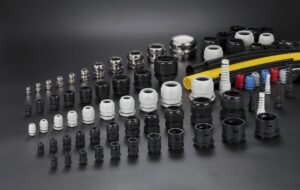ケーブルグランド製造業界では、高品質の製品と創造的なアイデアで多くの中国企業が際立っています。これらのメーカーは、さまざまな用途に適したケーブル グランドを多数取り揃えています。中国のケーブル グランド メーカー上位 10 社は以下のとおりです。
- ハイチ電気機械
- CMP製品
- ヒュンメルAG
- ウィスカ
- ラップグループ
- ABB(トーマス&ベッツ)
- TE コネクティビティ
- R. スタール AG
- ジェイコブ社
- ルグラン
ケーブルグランドとは何ですか?
ケーブルグランドは、ケーブル コネクタまたはフィッティングとも呼ばれ、電気設備でケーブルを固定および終端するために使用される重要なコンポーネントです。これらのデバイスは張力を緩和し、確実な接続を確保し、ケーブルの抜けやねじれを防ぎます。ケーブル グランドの最も重要な機能の 1 つは、ケーブル エントリ ポイントの完全性を維持できることです。防水ケーブル グランドにより水の浸入に対する保護が強化され、過酷な環境での使用に最適です。屋外用途。ケーブル入口を密閉することにより、困難な条件下でも電気システムが安全に動作し続けることが保証されます。
 ケーブルグランドメーカー
ケーブルグランドメーカー
クリックしてハイタンを表示 ケーブルグランド 製品>>
ケーブルグランド仕様
ケーブルグランドには、さまざまな業界の多様なニーズを満たすためにさまざまな仕様があります。主な仕様は次のとおりです。
- 材料:真鍮、ステンレス、アルミニウム、プラスチック
- ねじの種類: メートル法、PG、NPT、BSP
- 侵入保護:IP66、IP67、IP68
- ケーブル範囲:収容可能なケーブル径の範囲
- 温度範囲: グランドが耐えられる動作温度
ケーブルグランド全部品名称
- 腺体: 他のすべてのコンポーネントを収容する主要部分。
- シール:ぴったりフィットして湿気やホコリの侵入を防ぎます。
- ロックナット:グランド本体をパネルや筐体に固定するために使用します。
- Oリング: 追加のシーリングを提供して侵入保護を強化します。
- クランピングインサート: ケーブルをしっかりと保持し、張力を軽減します。
- グランドナット:ケーブル周囲のグランドを締め付け、しっかりとフィットします。
さまざまな種類のケーブル グランド
資料によると
- 真鍮ケーブルグランド:耐久性が高く、過酷な環境でも使用できます。
- ステンレス鋼ケーブルグランド:耐食性があり、海洋産業や化学産業に最適です。
- プラスチックケーブルグランド: 軽量で、それほど要求の厳しい用途に使用されます。
- アルミケーブルグランド:軽量でコスト効率が高く、一般的な用途に適しています。
ねじの種類による
- メートルねじケーブルグランド:ヨーロッパで一般的な、正確なねじ切り。
- PG スレッド ケーブル グランド: 産業用途で広く使用されています。
- NPT ねじケーブル グランド: 北米で一般的なテーパーねじ。
- BSP スレッド ケーブル グランド: 英国規格のパイプねじ切り。
用途に応じて
- 産業用ケーブルグランド:頑丈で耐久性があり、重工業で使用されます。
- マリンケーブルグランド: 防水性、耐腐食性があり、海洋環境で使用されます。
- 防爆ケーブルグランド: 危険場所用に設計されています。
- EMCケーブルグランド: 電磁両立性を提供します。
圧縮タイプ別
- シングル圧縮ケーブルグランド: 基本的なシーリングと張力緩和を提供します。
- 二重圧縮ケーブルグランド: 強化されたシールと張力緩和を提供し、高振動環境で使用されます。
 さまざまな種類のケーブル グランド
さまざまな種類のケーブル グランド
ケーブルグランドのサイズ
ケーブルグランドのサイズはどのように選択すればよいですか?
正しいケーブル グランド サイズを選択するには、ケーブル直径、ネジの種類、およびグランドが使用される環境条件を考慮する必要があります。しっかりとフィットし、適切に密閉できるように、サイズはケーブルの直径と一致する必要があります。
ケーブルグランドサイズ表
| ケーブル径(mm) |
グランドサイズ (メートル法) |
グランドサイズ (PG) |
グランドサイズ (NPT) |
| 3 – 6 |
M12 |
PG7 |
1/4″ |
| 6 – 10 |
M16 |
PG9 |
3/8″ |
| 10 – 14 |
M20 |
PG11 |
1/2″ |
| 14 – 18 |
M25 |
PG13.5 |
3/4″ |
| 18 – 25 |
M32 |
PG16 |
1″ |
| 25 – 33 |
M40 |
PG21 |
1 1/4″ |
| 33 – 42 |
M50 |
PG29 |
1 1/2″ |
| 42 – 54 |
M63 |
PG36 |
2″ |
ケーブルグランドの材質
ケーブル グランドは、アプリケーション要件に応じてさまざまな材料で作られています。
- 真鍮:耐久性が高く、過酷な環境に最適です。
- ステンレス鋼:耐食性に優れています。
- プラスチック(ナイロン):コスト効率が高く、軽量です。
- アルミニウム:軽量で一般的な使用に適しています。
- ニッケルメッキ真鍮:真鍮の強度と耐食性を兼ね備えています。
ケーブルグランドはどのように機能しますか?
ケーブル グランドは、ケーブルを機器にしっかりと固定すると同時に、張力を緩和し、環境要因から保護します。
ケーブルグランドが使用される理由
ケーブル グランドは次の用途に使用されます。
- ケーブルの損傷を防ぐために張力を緩和してください。
- 安全で安定した接続を確保します。
- 湿気、ほこり、化学物質などの環境要因からケーブルを保護します。
- エンクロージャの侵入保護定格の完全性を維持します。
ケーブルグランドはどこに使用されますか?
ケーブル グランドは、次のようなさまざまな用途に使用されます。
- 産業用機械・装置
- 電気パネルと筐体
- 海洋および海洋環境
- 危険区域 (例: 石油およびガス産業)
- 通信およびデータセンター
最終的な考え
この記事では、仕様、タイプ、材質、用途など、ケーブル グランドの詳細な概要を説明します。トップ10を紹介します ケーブルグランドメーカー 中国で。この記事では、ケーブル グランドとは何かを説明し、そのさまざまな部品をリストし、材料、ねじのタイプ、用途、圧縮タイプに基づいたさまざまなタイプについて詳しく説明します。また、正しいケーブル グランド サイズを選択するためのガイドとサイズ表も提供します。ケーブル グランドに使用される材料と、その具体的な利点について説明します。最後に、この記事では、ケーブル グランドの仕組み、張力緩和におけるケーブル グランドの重要性、さまざまな業界でのケーブル グランドの使用方法について説明します。安全で信頼性の高い電気接続を確保します。
ケーブルグランドに関するご質問・ご相談がございましたら、お気軽にお問い合わせください。 メールでお問い合わせください。業界リーダーとして、Haitan Electromechanical は 20 年以上の製造経験があり、ISO9001、CE、RoHS などの複数の国際認証を取得しています。月産100万個を超える生産能力により、短納期と高品質な製品をお届けします。当社の専門家チームがいつでもご質問にお答えし、専門的なアドバイスとサポートを提供いたします。